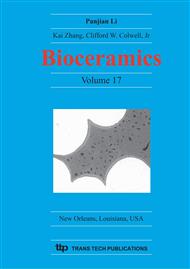p.679
p.683
p.689
p.693
p.697
p.701
p.705
p.709
p.713
Competing Damage Modes in All-Ceramic Crowns: Fatigue and Lifetime
Abstract:
A study is made of fracture from cyclic loading of WC spheres on the surfaces of brittle layers on compliant substrates, as representative of repetitive occlusal contact on dental crowns. Several damage modes—radial cracks at both top surface and cementation interface, and classical cone cracks as well as deep penetrating cone cracks from the top surface—have been identified and analyzed. The most dangerous fractures are radial cracks that initiate from either the top or bottom surfaces of the brittle layers and spread laterally to failure. In fatigue, these cracks are driven by chemical forces associated with the intrusion of water into the crack. Also dangerous are deep penetrating cone cracks which, unlike their classical cone crack counterparts, are mechanically driven by hydraulic pumping and can evolve rapidly with cyclic loading, threatening the lifetime of a dental crown veneer.
Info:
Periodical:
Pages:
697-700
Citation:
Online since:
April 2005
Authors:
Keywords:
Price:
Сopyright:
© 2005 Trans Tech Publications Ltd. All Rights Reserved
Share:
Citation:


